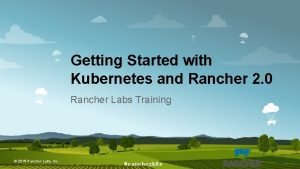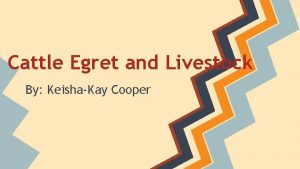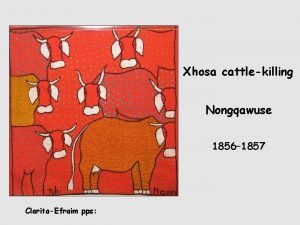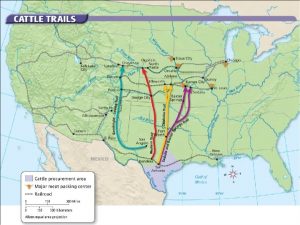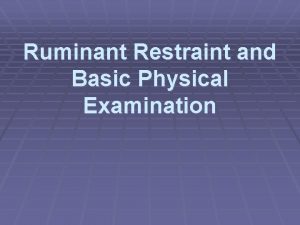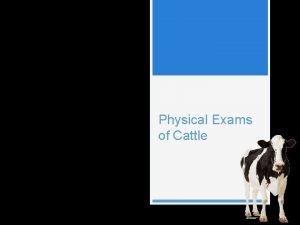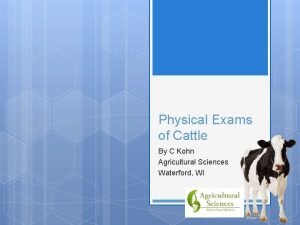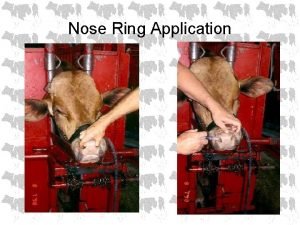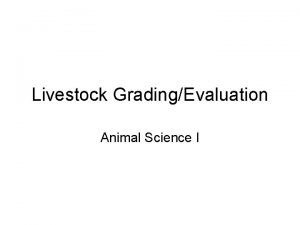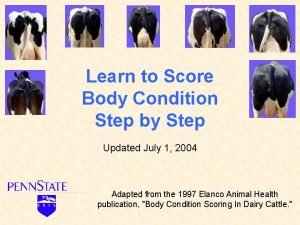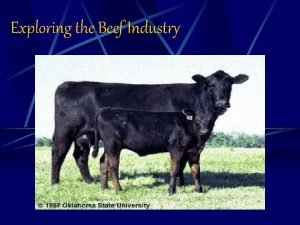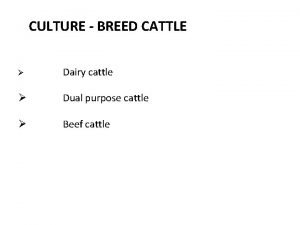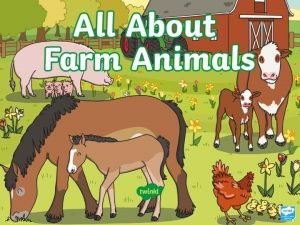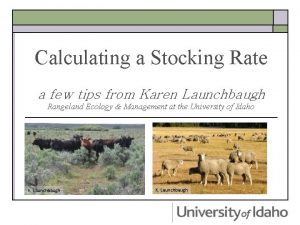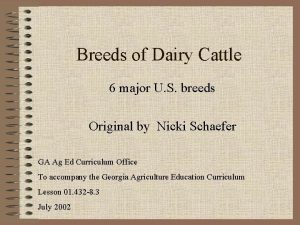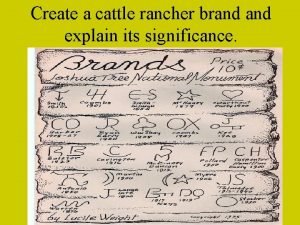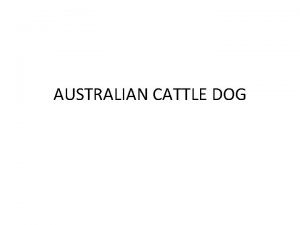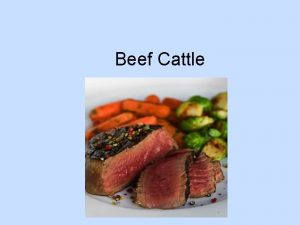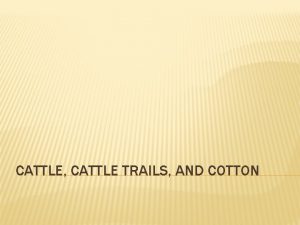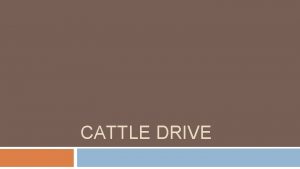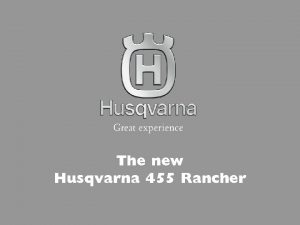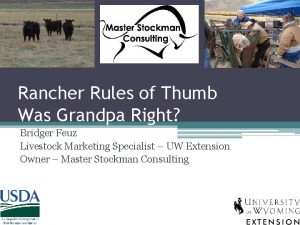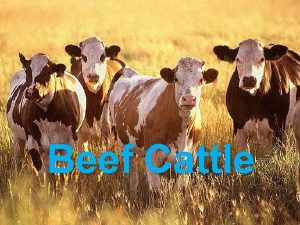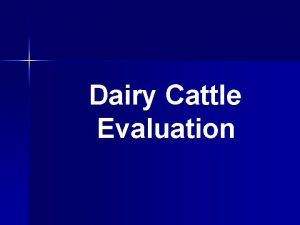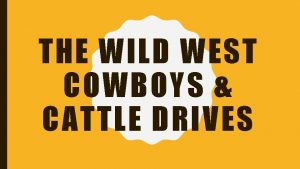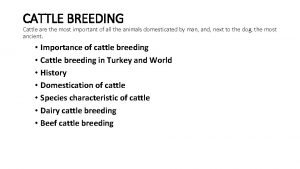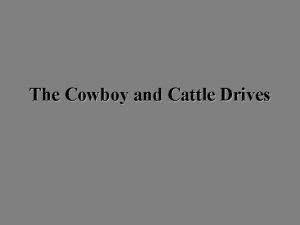Cattle Cattle Math You are a rancher in
























- Slides: 24

Cattle

Cattle Math You are a rancher in Texas and your currently have 300 head of cattle. The going rate for cattle in Texas is $4 a head. You hear that the going rate for cattle in Kansas City is $38 and $80 a head in New York. What is the modern day value of your herd knowing of course that the $4 in 1865 is equivalent to $64 today? What is the potential value of your herd if you get all 2, 000 head of cattle to New York? How are you going to get the cattle from Texas to New York?

Texas Cattle Trails

The Cattle Drives Demand for beef outpaced supply in the Northeast. The region had a large population and its cattle supply had been greatly reduced by the Civil War. But in Texas the supply of cattle was greater than the demand for beef. As a result, cattle that sold for $3 or $6 a head in Texas sold for $38 in Kansas or $80 in New York.

The Cattle Drives Such high prices convinced Texas ranchers that they could make large profits by raising more cattle. However, ranchers could not drive longhorns eastern markets because of the distance and the many populated farm areas the herds would have to cross.

Supply and Demand & Technology

The Cattle Drives By 1865, stockyards, or huge holding pens, and packing houses were opening in Chicago. Soon, more beef-processing plants were built further west, in St. Louis and Kansas City. These plants were built to prepare the beef for shipment to cities in the North and East. Kansas City Stockyards

The Cattle Drives Railroads connected cities in midwestern states such as Missouri with larger cities in the Northeast. Texas ranchers needed a way to get their cattle to the nearest railroad lines.

http: //stagevu. com/video/rfqmgyo flfni

The Cattle Drives During the fall and winter, cattle grazed on the open range, or unfenced lands, of Texas. As spring approached, cowboys gathered the cattle together in a roundup. Cowboys caught as many mavericks as possible and branded them to establish ownership of the animals.

The Chisholm and Western Trails In 1867, Texas cowboys herded about 35, 000 longhorns over the Chisholm Trail. The route to Abilene was named after Jesse Chisholm, a fur trader. The child of a Cherokee woman, Chisholm blazed the original trail in the mid-1860 s to trade with the American Indians. Jesse Chisholm

The Chisholm and Western Trails His trail went through Indian Territory to Kansas. The Chisholm Trail was an ideal route for Texas cattle drives because it was not near farms. Over the next few years, even more cowboys used this trail to move their herds to Abilene.

The Chisholm and Western Trails In 1871, some 600, 000 to 700, 000 longhorns arrived in the cow town. At the end of the drive, most ranchers sold the animals for a good profit and paid the cowboys in cash.

The Chisholm and Western Trails Texas ranchers soon needed a new trail across open range to the west of settled territory. The Western Trail was forged in 1874. The (Great) Western Trail

Texas Cattle Trail Map

Roundup on Texas Ranch

Life on the Trail

"Where we shine. " Cowboys at the end of an 1897 roundup in Ward County, Texas, pose with their herd of almost 2, 000 cattle. By this time, barbed wire had closed down the long cattle trails for nearly two decades. Photographed by F. M. Steele.

Life on the Trail A typical cattle drive had 8 to 12 cowboys to care for 2, 000 to 3, 000 cattle. Each cowboy used several horses in relays of two to three, so that a fresh mount was always available. The herd of these animals was know as the remuda, the Spanish word for “remount”. A wrangler cared for the crew’s horses.

Life on the Trail The camp cook was another important member of the drive crew. Good food meant happy cowboys. The cook traveled ahead of the herd and had meals prepared when the rest of the outfit arrived.

Life on the Trail The cook’s supplies were carried in the chuck wagon, or the covered supply wagon. A day on the trail began before sunrise. After a hot breakfast of bacon beans and biscuits, the cowboys would choose their horses from the remuda and start to move the cattle.

Life on the Trail Two highly experienced cowboys called point men guided the herd. Drag men traveled behind the herd. This was the drives worst position because drag men “ate” dust the whole trip. On a good day, the herd would move 15 to 18 miles.

Cowboys eating dinner on the range. A typical chuck wagon, like the one shown here, carried potatoes, beans, bacon, dried fruit, cornmeal, coffee and canned goods. (Library of Congress)

The end of Cattle Drives Cattle drives lasted for about 20 years. They began in the 1860’s and ended in the 1880’s. They ended for 4 reasons: 1. The invention of Barbed Wire-a twisted wire with a sharp barb, or point, every few inches. 2. The growth of railroads-built in 1870 in Texas 3. Too many cattle grazed on crowded ranges-there was not enough grass for all the cattle 4. Cold Temperatures during 1886 -1887 -freezing weather killed thousands of cattle
 Antigentest åre
Antigentest åre Rancher get started
Rancher get started Cattle egrets and livestock
Cattle egrets and livestock Math game math hit the button
Math game math hit the button Rain
Rain Agree or disagree questions about life
Agree or disagree questions about life If you think you can you can poem
If you think you can you can poem Tell me what you eat and i shall tell you what you are
Tell me what you eat and i shall tell you what you are I follow you wherever you go
I follow you wherever you go Story of nongqawuse
Story of nongqawuse Xhosa cattle killing outcome
Xhosa cattle killing outcome Texas cattle drive map
Texas cattle drive map Slidetodoc.com
Slidetodoc.com Withers pinch test in cattle
Withers pinch test in cattle Withers pinch test in cattle
Withers pinch test in cattle Master cattleman program
Master cattleman program Vagus indigestion in cattle
Vagus indigestion in cattle Beefsex
Beefsex Hooks and pins cattle
Hooks and pins cattle Beef cattle parts
Beef cattle parts Conveyor belt cattle feeder
Conveyor belt cattle feeder Dual-purpose cattle
Dual-purpose cattle Cow
Cow How to calculate stocking rate for cattle
How to calculate stocking rate for cattle 6 breeds of dairy cattle
6 breeds of dairy cattle

